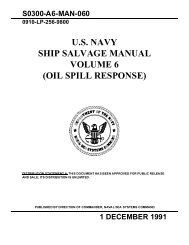U.S. NAVY SALVAGE REPORT DEEPWATER HORIZON ... - ESSM
U.S. NAVY SALVAGE REPORT DEEPWATER HORIZON ... - ESSM
U.S. NAVY SALVAGE REPORT DEEPWATER HORIZON ... - ESSM
You also want an ePaper? Increase the reach of your titles
YUMPU automatically turns print PDFs into web optimized ePapers that Google loves.
Chapter 1: Introduction<br />
OPNAV Instruction 4740.2G, tasks NAVSEA 00C, SUPSALV, to execute the responsibilities of<br />
the Salvage Facilities Act, to procure, maintain, and distribute salvage and related pollution<br />
abatement material to the Emergency Ship Salvage Material (<strong>ESSM</strong>) bases, and to provide<br />
capability for response to Oily Hazardous Substances (OHS) releases on the open ocean or<br />
incident to salvage operations.<br />
OPNAV Instruction 5090.1C is the Navy’s Environmental Readiness Program which ensures that<br />
the Navy operates worldwide in an environmentally responsible manner. The Program identifies<br />
spill preparedness and response guidance in Chapter 12. Specifically, it directs that facilities<br />
comply with 33CFR154 and vessels with the planning requirements of OPA-90 and 33CFR155<br />
despite legal exemption as a “public vessel”. Many Navy vessel and Navy facility plans cite<br />
SUPSALV as an Oil Spill Response Organization (OSRO) for Worst Case Discharge spills.<br />
OPNAVINST 5090.1C requires that SUPSALV:<br />
• Ensures that the Navy’s equipment inventory for major and offshore spill events is<br />
drilled/exercised in accordance with USCG implementing regulations of OPA-90<br />
• Assist NOSCs in major OHS pollution response issues as they arise and in decisionmaking<br />
for major or offshore/salvage related response operations<br />
• Provide expertise and equipment for spills exceeding local capability<br />
• Provide advice, personnel, and equipment, as appropriate for joint/pollution operations.<br />
1-4.2 Differences Between Planned Capability and this Operation<br />
The Navy sizes its oil response capability to respond to its largest vulnerability as defined by<br />
33CFR164/155. That vulnerability is the Fleet Oiler Champion Class which has a length on deck<br />
of 615 feet and a displacement of 40,000 tons. The fuel oil bunker capacity is 237,000 barrels.<br />
<strong>ESSM</strong> equipment is ordered and maintained to respond to a spill from a single one of these<br />
ships in either a harbor/river or in the ocean. With Naval bases focused on their own<br />
responsibility at the base, (in-shore capability), SUPSALV has emphasized preparations for an<br />
ocean event. The DWH oil spill was several orders of magnitude larger than this “Navy worst<br />
case” scenario. As a result, while SUPSALV could bring significant resources to the scene, the<br />
actions of SUPSALV alone could not come close to containing the estimated 40,000 bbls per<br />
day 1 (4.9 million bbls total) that spilled into the Gulf.<br />
1 The amount of oil spilling into the Gulf of Mexico was a matter of public speculation for a number of<br />
months. BP’s initial estimate of 1,000 bbls was thought to be lower than the actual flow but independent<br />
estimates were not available until a 12 May video gave the public a first look at oil flowing from a recently<br />
cut drill riser. News outlets attempts to estimate the volume prompted the Coast Guard, on 19 May, to<br />
commission a Flow Rate Technical Group allowing for an informed independent estimate of the flow rate.<br />
On 11 June, based on the committee’s analysis, the flow rate was estimated to be between 20,000 and<br />
40,000 bbls per day. That week, Admiral Thad Allen was quoted estimating the oil flow rate between<br />
12,000 and 25,000 bbls per day with a production (capture at the well head) between 6,000 and 10,000<br />
bbls per day. On 4 August, the Flow Rate Technical Committee revised their estimates and reported that<br />
the well was initially dumping 62,000 bbs per day into the gulf and that rate had diminished to 53,000 bbls<br />
per day by the time the well was capped.<br />
1-4

















